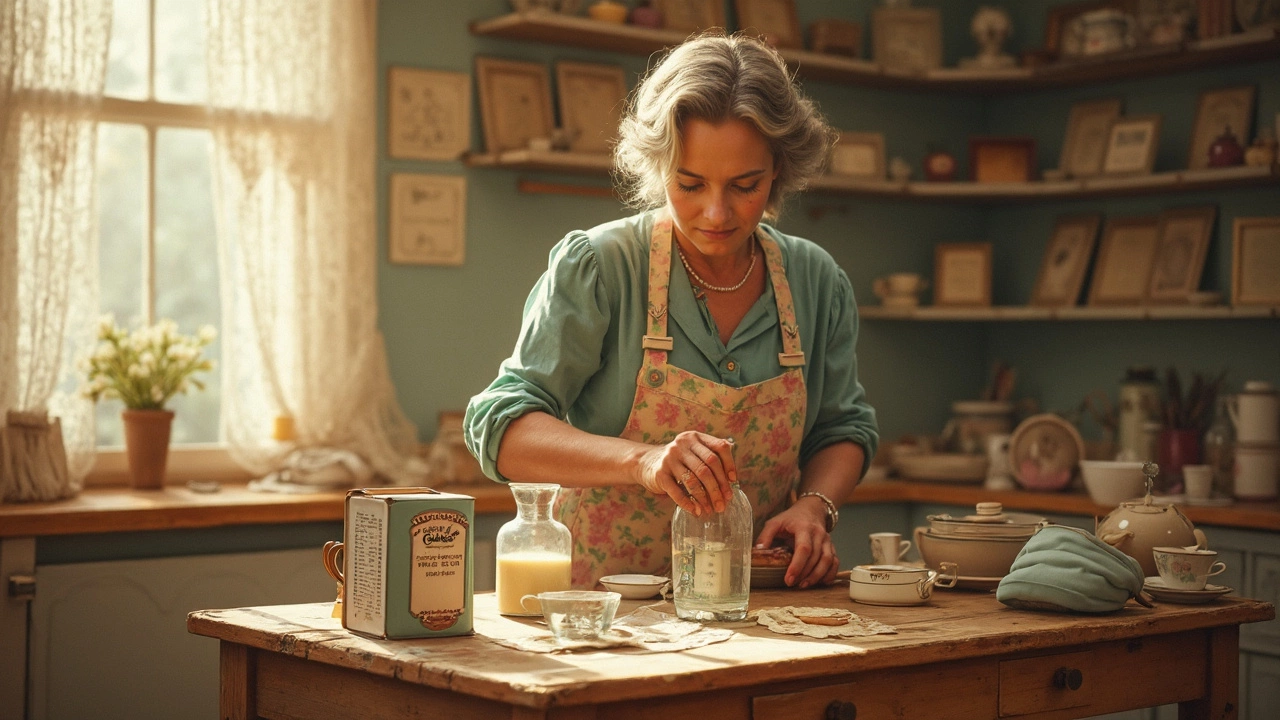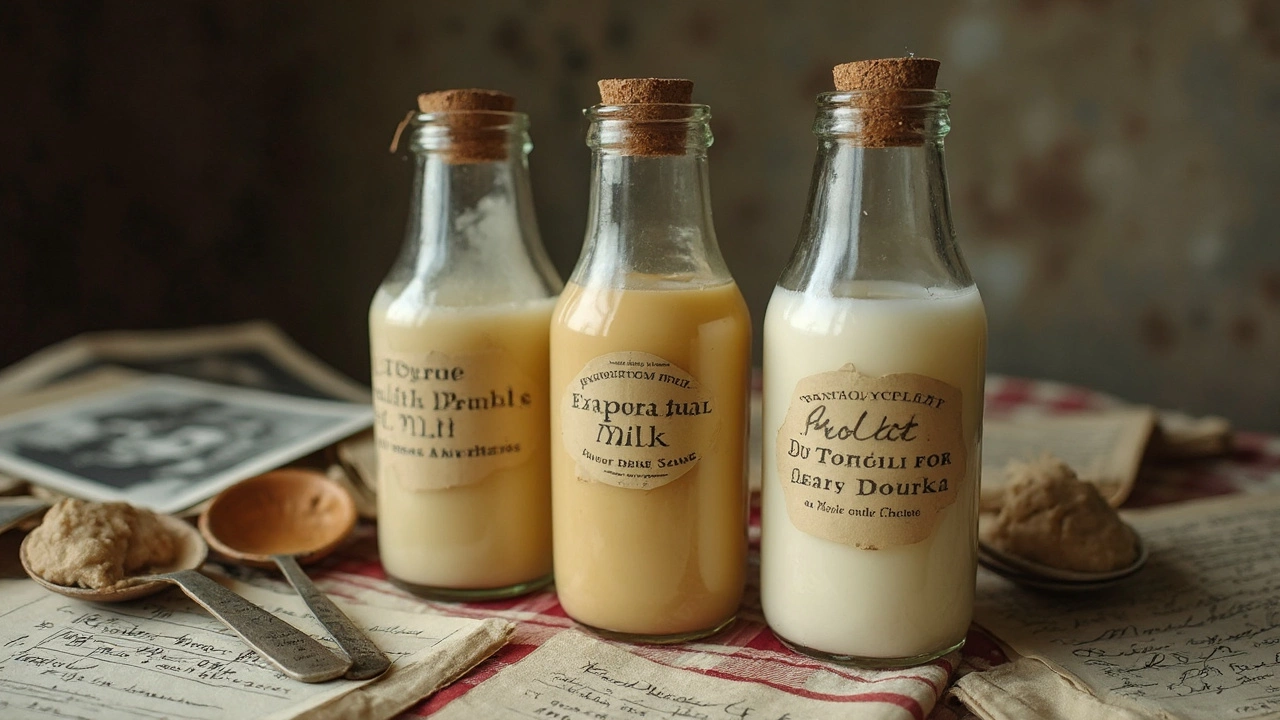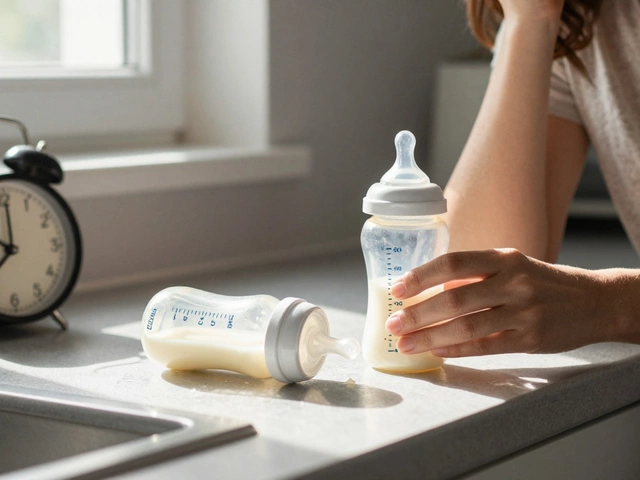
Ever look at a can of baby formula and wonder what your grandma or great-grandma used? Back when formula wasn’t stacked on every store shelf, parents got creative—and sometimes desperate—about what they fed their babies. The most famous old fashioned baby formula often came from kitchens, not factories.
People used canned milk, water, a scoop or two of sugar or corn syrup, and maybe some vitamins, if they were lucky enough to have them. They’d mix things up with simple kitchen tools—no fancy bottles, just whatever they had on hand. Doctors even handed out typed-out recipes and ratios, like “add 2 ounces evaporated milk to 4 ounces water and 1 teaspoon of Karo syrup.”
Sounds straightforward, right? But the reality was complicated and sometimes risky. Babies could get too much or too little nutrition, and if someone made a mistake, things could go wrong fast. Still, for many families, there was no other choice. Let's get into what exactly went into those bottles—and what you really need to know if you’re curious (or a little nostalgic) about vintage baby feeding.
- Why People Made Homemade Formula
- What Went Into Old Fashioned Baby Formula
- The Most Common Recipes From the Past
- The Big Risks and Missing Pieces
- Safer Ways If You’re Tempted to Try
- What Science Says Today
Why People Made Homemade Formula
Back when commercial formulas weren’t a thing, families had to improvise. Store-bought formula wasn’t widely available until the middle of the 20th century, and even then, it could be hard to find, expensive, or just not trusted. Back then, if a mom couldn’t breastfeed—maybe because of illness, death, poor milk supply, or simply needing to go back to work—people got creative in the kitchen.
In the 1920s and 1930s, doctors often handed out recipes for what came to be called “evaporated milk formulas.” One common reason was pretty practical: regular cow’s milk could be too harsh or lacking the stuff a baby’s body really needed, whereas canned evaporated milk was safer, more consistent, and easy to store. The American Academy of Pediatrics has even noted,
"Before the 1950s, evaporated milk formulas provided adequate nutrition for most infants, especially when prepared according to physician instructions."
Back then, hospitals and public health nurses often coached mothers on boiling water, sterilizing bottles, and mixing up the formula with the right ratios. It seemed safer than risking unpasteurized cow’s milk, which could easily spoil and sometimes spread diseases.
- Some folks were just trying to make ends meet. Evaporated milk and corn syrup were cheap compared to anything pre-mixed or imported.
- There was also a lack of breastfeeding support or knowledge. In some places, formula was seen as ‘modern’ or more scientific.
- If a baby had trouble digesting breast milk or mom just physically couldn’t breastfeed, there weren’t many other options on the table.
The truth is, old fashioned baby formula was born out of necessity. Most families weren’t looking for the healthiest choice—they just wanted their babies fed and alive. Understanding why homemade formula was so common helps explain both its place in history and why some families still ask about it today.
What Went Into Old Fashioned Baby Formula
This is where things get really interesting (and honestly, a little wild by modern standards). Back in the day, there was no big brand formula mix—most parents threw together whatever their doctor or neighbor recommended. The most basic recipe usually had three ingredients:
- Evaporated milk (or sometimes whole cow's milk)
- Water (often boiled and cooled)
- Sugar—usually in the form of corn syrup like Karo, but sometimes table sugar
Evaporated milk was a big hit because it was shelf-stable and cheaper than fresh milk. But, cow’s milk on its own is way too high in protein and minerals for tiny babies, so doctors told parents to dilute it. That’s where water came in. The sugar wasn’t just for taste; it supposedly added calories and helped with digestion (according to the advice at the time).
Take a look at a formula handed out by pediatricians in the 1940s to 1960s:
| Ingredient | Amount per Bottle (Approx.) |
|---|---|
| Evaporated Milk | 2 ounces |
| Water (boiled) | 4 ounces |
| Corn Syrup (Karo) | 1 teaspoon |
This made about one bottle. Parents would prep enough for a whole day and store bottles in the fridge. Some people swapped out corn syrup for honey—bad idea now, since honey can be unsafe for babies. A few went the extra mile and added vitamin drops, since everyone knew plain milk didn’t have enough iron or vitamin C.
It's worth mentioning that these old fashioned baby formula recipes had big gaps in nutrition compared to today's options. No DHA, no prebiotics, not always enough vitamins or minerals, and risky if mixed wrong. But if you ask someone who grew up on this stuff, they’ll probably say, “Hey, I survived.” Still, times have changed for a reason.
The Most Common Recipes From the Past
If you ever peeked at an old baby care book or talked to older relatives, you probably heard about formulas based on evaporated milk. Back in the 1940s and 1950s, roughly 50% of babies in the U.S. were raised on homemade mixes instead of breast milk. The most basic and widely used recipe sounded almost too simple: mix canned milk, water, and a sweetener.
Here’s what the classic homemade formula usually looked like:
- 2 ounces evaporated milk (like Carnation or Pet)
- 4 ounces boiled water
- 1 or 2 teaspoons of Karo syrup (corn syrup) or table sugar
They'd combine everything in a sterilized bottle, shake it up, and sometimes add vitamin drops. Doctors or nurses often gave parents sample recipe cards when their babies weren’t breastfed. The sweetener was there for extra calories and to help prevent constipation, since evaporated milk can plug up little tummies.
Another less common—but still popular—method swapped out evaporated milk for regular cow’s milk, sometimes diluted even more and with a bit more sugar. But most doctors thought evaporated milk was safer, since it was canned and less likely to spoil quickly.
Check out this table of two common vintage formulas:
| Ingredient | Evaporated Milk Formula | Diluted Cow's Milk Formula |
|---|---|---|
| Milk Base | Evaporated milk (2 oz) | Whole cow’s milk (2 oz) |
| Water | 4 oz, boiled then cooled | 6 oz, boiled then cooled |
| Sweetener | 1–2 tsp corn syrup or sugar | 1–2 tsp corn syrup or sugar |
| Vitamins | Optional drops | Optional drops |
One big thing people forget: these formulas didn’t provide the same nutrition as today's specialized options. There was a real risk of missing out on key stuff like iron and certain vitamins. Still, for families without access to commercial powder, that old fashioned baby formula recipe was what kept babies going.

The Big Risks and Missing Pieces
Making old fashioned baby formula wasn’t just about mixing milk and water. There were some huge risks hiding in those simple bottles. First, home recipes almost never hit the right balance of protein, fat, and vitamins babies actually need. Tiny bodies are picky—too much salt, too little iron, or not enough vitamin D could cause real problems.
Let’s talk about contamination. In the 1940s or 50s, home refrigerators couldn’t keep things as cold as ours do now, so milk would spoil fast. Add in that tap water wasn’t always safe, and washing bottles couldn’t kill all the germs. This meant some babies picked up tummy bugs just from what was in their bottle.
Another big hole: formulas were missing key nutrients. Homemade mixtures usually lacked iron, vitamin C, and vitamin D. Iron is a big deal—babies without enough can end up with anemia or slow brain development. In fact, studies from the 1960s showed up to 30% of bottle-fed babies on old-fashioned recipes ended up iron-deficient. That’s not a small number. Rickets (bone problems from not enough vitamin D) popped up so often doctors started giving cod liver oil just to fill in the gaps.
| Common Risk | Why It Matters |
|---|---|
| Contaminated milk or water | Could cause infections and stomach problems |
| Lack of iron | Led to anemia and poor growth |
| Missing vitamins (like D or C) | Caused bone issues and weak immune systems |
| Wrong calorie count | Babies could be underfed or get unhealthy weight |
Doctors saw a lot of babies coming in underweight, or sometimes overweight, just because parents got the ratio a little wrong. Unlike today’s commercial formulas where every scoop is carefully measured, homemade ones were easy to mess up—with real consequences.
Even though these problems are well-documented now, back in the day, parents just didn’t have the info or tech we rely on. If a recipe was passed down from a neighbor, no one double-checked the science.
Safer Ways If You’re Tempted to Try
If you’re thinking about making old fashioned baby formula at home, you’re definitely not alone. It’s all over TikTok, and some parents genuinely wonder if homemade is somehow better. The thing is, today’s science-backed formulas aren’t just convenience—they’re built with decades of hard lessons about nutrition, safety, and what babies actually need. But if you’re itching to whip something up because you ran out of store-bought formula or want to try what your grandma did, here’s what you need to know before even picking up a can of milk.
First off, the American Academy of Pediatrics (AAP) and the CDC are clear: homemade baby formulas can be risky for little ones. In fact, studies show homemade formulas can easily leave babies low on crucial nutrients, especially iron and vitamin D. There’s also danger of too much salt, sugar, or even bacteria, especially if water or utensils aren’t 100% clean.
- Do not use raw or unpasteurized milk—it can seriously hurt your baby’s tummy and lead to infection.
- Skip adding honey—babies under one year shouldn’t have it, ever, due to the risk of botulism.
- Stay away from coconut, almond, or rice milks. They sound healthy, but they just don’t deliver the nutrition babies need for growth.
If you’re in a bind and store formula is out of reach, the safest route is to talk to your pediatrician or a registered dietitian first. Sometimes they can help work out a temporary plan or even connect you with formula banks or local resources. Some pharmacies and hospitals have emergency supplies. If it’s a real shortage situation, call your local health department. They actually keep a list of safe options, and some will even help locate formula near you.
Quick numbers show how risky the homemade option is. One study published in 2021 looked at homemade formula cases across the U.S. and found that over 80% of babies fed these recipes at home had some kind of deficiency or health issue pop up. Some even ended up in the hospital.
| Homemade Formula Risk | Potential Outcome |
|---|---|
| Low iron or vitamin D | Anemia, weak bones, delayed growth |
| Too much sugar or corn syrup | Digestive trouble, risk of obesity |
| Unclean water or utensils | Serious infections |
| Wrong ratios or missing nutrients | Seizures, heart problems |
If you absolutely have to make something at home, be super careful. Use pasteurized whole cow’s milk only as a very short-term backup—and only for babies over 12 months. Babies under that age can’t handle the protein and mineral load in cow’s milk, so it’s a last resort. Never try to invent your own old fashioned baby formula mix. Follow trusted medical advice.
Here’s the honest truth: formula today is way more than what you see on the can, and those old recipes just can’t measure up in safety or nutrition. Chat with your doctor if you have questions—they can help you keep your baby happy, healthy, and fed, no matter what resources you have.
What Science Says Today
Modern science is clear—homemade formulas, even the “old fashioned” ones, are seriously risky for babies. Today, pediatricians and nutritionists agree: store-bought formulas are not just about convenience, but safety and nutrition.
The reason? Babies need more than just calories. Their brains, organs, and immune systems are all in overdrive. They need the right mix of protein, fat, vitamins, and minerals, all in forms their bodies can actually use. Most homemade recipes—especially those made from evaporated milk and corn syrup—miss the mark on several critical nutrients like iron, vitamin D, and certain fatty acids. This has led to reports of babies suffering from seizures, anemia, and growth issues when fed these mixes over months.
Food safety is another big deal. Factory-made old fashioned baby formula is built under tight controls: sterilized equipment, exact measurements, and regular safety checks. In home kitchens, even a small mistake with measurements or cleaning can introduce harmful bacteria and cause infections. The CDC and American Academy of Pediatrics both warn against homemade formulas because of these dangers.
Here’s what experts say you should do instead:
- Choose a commercial formula that meets FDA standards—there's a reason they're strictly regulated.
- If your baby needs a special diet, talk to your pediatrician; sometimes formulas can be custom-ordered for allergies or rare conditions.
- If you’re struggling to afford formula, there are programs like WIC that help families get what they need.
If you come across a vintage formula recipe online, remember: just because it worked for some families decades ago doesn’t mean it’s safe or good for babies today. Science has moved forward, and so have our options to keep little ones safe and healthy.






